Nara Prefecture’s Traditional Events
Here we will introduce the year-round calendar of traditional events held throughout Nara Prefecture. Entwined with the livelihoods of people of all ages, these events have been passed along for many generations, and include events more than a thousand years old, as well as peculiar festivals that could well be described as strange.
These assorted traditional events, which can trace an unbroken line back into antiquity, have clearly taken root in the regions from which they come.
By experiencing these events, and learning more about their backgrounds, you are sure to discover the rich charms of each of the regions.
Come and see these traditional events for yourself, and be a witness to Nara’s folklore.
*Please flick to see.
*Please flick to see.

Spring April Taima-dera Nijugobosatsuraigoe (traditional procession)
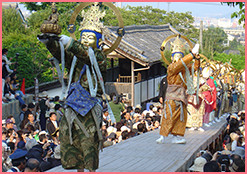
In Taima-dera Temple, in the city of Katsuragi, the Taima Mandala, a national treasure said to have been woven by the noblewoman Chujo-hime in a single night, has been passed down through the generations. After weaving the mandala, Chujo-hime is believed to have been carried away to the heavens by the Amida Buddha and twenty-five bodhisattvas.
This legend is recreated in the Taima-dera nijugobosatsuraigoe.
Within the temple grounds, upon a long, raised bridge, the scene is recreated with twenty-five bodhisattvas proceeding up and down the bridge, leading Chujo-hime from the earthly world to the heavenly one.
This service is said to have been held for more than a thousand years, since 1005.
Spring May Yamato-no-nogami-gyoji (traditional rituals)
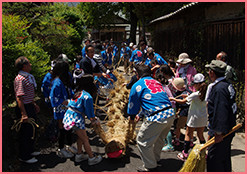
Nogami is one of the guardian deities of rice farming and agriculture, and events that venerate this deity are known as nogami-gyoji.
Yamato-no-nogami-gyoji brings together such events from throughout Nara Prefecture, and was selected as an Intangible Folk Cultural Property warranting measures such as the creation of a national record.
The typical form for the event is for children to carry a straw rope in the shape of a snake, and after they have paraded around the area, the straw rope is offered to Nogami. However, there are many regional variations, and in one type, small children’s bodies are painted in ink to pray for good harvests.
You can have fun visiting each of the regions and comparing the differences.
Summer August Totsukawa-no-oh-odori (traditional Bon dance)
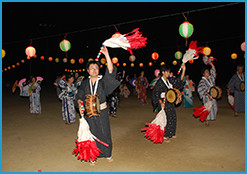
This is a type of furyu-odori (in which the lyrics of a ballad are sung to the rhythm of taiko drums, while members of the group dance) said to have been passed down for more than 300 years in the village of Totsukawa.
Now, in three areas that make up the village—Ohara, Musashi, and Nishigawa—dances are held in schoolyards or similar places during the Bon Festival each August. It’s a magnificent dance with the taiko drums beaten with drumsticks to which beautiful tassels have been attached, while participants hold folding fans or carry pieces of bamboo from which cut-glass lanterns hang.
The dance communicates the bold energy of the people who live in the villages between the mountains to today’s audiences.
Summer August Sakamoto-odori (traditional dance)
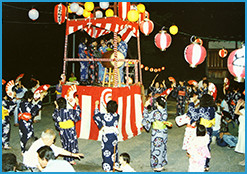
This Bon Festival dance, representative of dances passed down in the Okuyoshino area, is performed on August 15 at Sakamoto Ten-jinja Shrine in Oto-cho, Gojo City.
It is a circular dance, where the dancers form a ring around the chorus leader and dance with either empty hands or with folding fans.
Some of the varieties of this dance tell a story, such as the masakichi-odori, which mourns the spirit of Nakamura Masakichi, who accepted the death penalty in place of the men of the village who had committed a crime.
Summer August Higashibojo-no-horanya (fire festival)
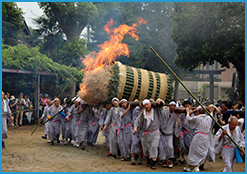
This fire event for the Bon Festival is a collaboration between Furukawa-cho and the five districts of Higashibojo-cho, in the city of Kashihara.
In each of the areas, torches are made by binding piles of wheat and rapeseed husks with green bamboo, and in the afternoon, these are carried by parishioners of Hachiman-jinja and Kasuga-jinja shrines in Higashibojo-cho. The largest torches can measure as much as around three meters in height, two meters in diameter, and 500 kilograms in weight. The torches are paraded around the shrine grounds by dozens of men as they burn.
The tradition is believed to drive the spirits of the dead and pestilence deities who cause droughts, insect damage, and plagues, away from the villages.
Autumn October Daimokutate (traditional performance)
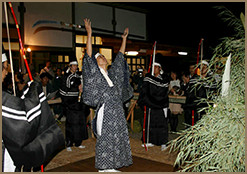
This is a form of narrative performance offered at Yahashira-jinja Shrine in Kamifukawa-cho, Nara City.
Each year on October 12, the day before a festival, it is performed by youths from Kamifukawa-cho.
The program takes the Gempei War as its theme, and the parts and lines are divided between the performers, who adopt special accents and intonation. At the end of the story, there is the fusho-mai dance.
This involves one performer making their way to the center of the stage before holding up a fan and stamping their way around one lap of the stage. That this kind of medieval story, which predates noh theater, still exists today, is extremely rare anywhere in Japan.
In 2009, daimokutate was inscribed as Intangible Cultural Heritage by UNESCO.
Autumn October Narazuhiko-jinja-no-okinamai (traditional dance)
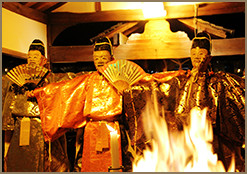
This form of folk performance art is offered at Narazuhiko-jinja Shrine in Narazaka-cho, Nara City, and this okina (“old man”) performance is said to be the origin of noh theater. It supposedly originates from a time 1,300 years ago when Prince Kasuga, the grandson of Emperor Tenji, fell ill, and his two sons prayed and danced for his recovery.
Each year on October 8, the day before a festival, it is performed over the course of about an hour. The cast covers a wide range of age groups, with the part of Senzai played by a child of about 13, and the part of the old men played by men of about 60. With three old men on stage, it is an unusual form of okina-mai, and as such is valued as a folk tradition.
Winter
December
Kasuga Wakamiya Onmatsuri-no-shinji Geino
(festival ritual entertainments)
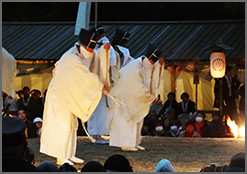
A variety of ritual entertainments are offered at the annual festival held at Kasugawakamiya-jinja Shrine in Nakatsuji-cho, Nara City, an auxiliary shrine to Kasuga-taisha Shrine, between December 15 and 18. They include the dengaku, bugaku, sarugaku, and yamato-mai performance arts, among others. It is said that towards the end of the Heian period in 1136, Fujiwara no Tadamichi, the chief advisor to the emperor, started to pray for a rich harvest, and this tradition has been preserved and continued to this day without break.
The event is synonymous with Nara and draws large numbers of people each year, and is highly important for its passing on of the origins of Japan’s performing arts.
Winter January Dadado-no-onihashiri (fire festival)
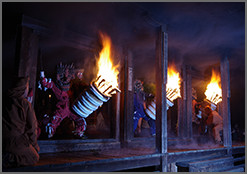
This event is held in the Dadado Hall at Nembutsu-ji Temple in Ozu-cho, Gojo City, to both ward off bad luck and pray for good.
It has been passed down in the Sakaaibe district for more than 500 years. Each year on January 14, passages from a Buddhist sutra are read, then the daytime onihashiri (“demon run”) ceremony is performed, fires are lit to beckon Buddha and the bodhisattvas, and in the evening another onihashiri ceremony takes place.
Three demons, with burning torches in their hands, walk around the hall three times, driving off calamity.
In this event, the demons are not chased off by humans, but perform the role of bringers of good fortune.
This representation of demons as bringers of luck is rare, and many pilgrims come to watch the event.
Winter January Chihara-no-tondo (bonfire festival)
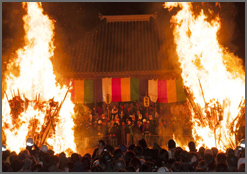
This fire festival is held for Little New Year at Kisshoso-ji Temple in Chihara, Gose City.
Within the temple grounds, two bonfires known as tondo standing six meters tall are erected, and each year on the evening of January 14, they are set alight and prayers are offered for a good harvest. These are the biggest bonfires in Nara Prefecture.
Kisshoso-ji Temple is said to have been established by the founder of the Shugendo sect, En-no-gyoja, and even now practitioners can be seen at the festival in their religious attire, blowing into conches and chanting sutras.
Winter January Shinohara-odori (traditional dance)
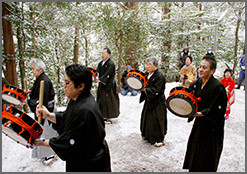
The “Dance of Shinohara” is a variety of elegant dance offered at Ten-jinja Shrine in Shinohara, Oto-cho, Gojo City.
It is said that the dance has its origins in a dance offered long ago by the whole village to thank local deities after a wolf that had been plaguing Shinohara and the surrounding area was defeated. Now, each January 25, the members of the dance’s preservation group perform three dances—the ironami-odori, yononaka-odori, and takara-odori.
Winter February Ettsumi/Onishi-no-otsuna (giant rope festival)
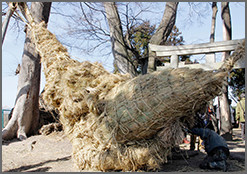
In the Ettsumi and Onishi districts of the city of Sakurai, this event is held each February 11 to pray for good harvests and conception.
The event is also known to locals as “Otsunahan-no-kekkonshiki” or “Otsuna-kake.”
At the Kasuga-jinja Shrine in Ettsumi, a “male” rope is made, and a “female” one is made at Ichikishima-jinja Shrine in Onishi, each weighing roughly 700 kilograms. These heavy ropes are carried to Susano-jinja Shrine, where they are tied together and hung from trees, after which a hand-clapping ceremony is held.
The event is said to have its origins in the wedding between the deities Susano-no-mikoto and Inadahime.
Related links
For those who’d like to know more…
Ikasu-Nara related links
-
- ・For more information on the preservation of Nara Prefecture’s cultural properties, see:





